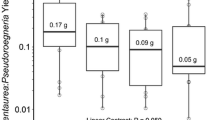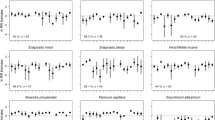Abstract
Genetic diversity within species is a potentially important, but poorly studied, determinant of plant community dynamics. Here we report experiments testing the influence of genotype identity and genotypic diversity both on the invasibility of a foundation, matrix-forming species (Kentucky bluegrass, Poa pratensis), and on the invasiveness of a colonizing species (dandelion, Taraxacum officinale). Genotypes of Kentucky bluegrass in monoculture showed significant variation in productivity and resistance to dandelion invasion, but the productivity and invasion resistance of genotypic mixtures were not significantly different from those of genotypic monocultures. Indirect evidence suggested temporal shifts in the genotypic composition of mixtures. Dandelion genotypes in monoculture showed striking and significant variation in productivity and seed production, but there was no significant tendency for these variables in mixtures to deviate from null expectations based on monocultures. However, productivity and seed production of dandelion mixtures were consistently greater than those of the two least productive genotypes, and statistically indistinguishable from those of the three most productive genotypes, suggesting the possibility of greater invasiveness of genotypically diverse populations in the long run due to dominance by highly productive genotypes. In both experiments, the identity of genotypes was far more important than genetic diversity per se.





Similar content being viewed by others
References
Agashe D (2009) The stabilizing effect of intraspecific genetic variation on population dynamics in novel and ancestral habitats. Am Nat 174:255–267
Booth RE, Grime JP (2003) Effects of genetic impoverishment on plant community diversity. J Ecol 91:721–730
Cardinale BJ, Srivastava DS, Duffy JE, Wright JP, Downing AL, Sankaran M, Jouseau C (2006) Effects of biodiversity on the functioning of trophic groups and ecosystems. Nature 443:989–993
Cardinale BJ, Wright JP, Cadotte MW, Carroll IT, Hector A, Srivastava DS, Weis JJ (2007) Impacts of plant diversity on biomass production increase through time because of species complementarity. Proc Natl Acad Sci USA 104:18123–18128
Crutsinger GM, Collins MD, Fordyce JA, Gompert Z, Nice CC, Sanders NJ (2006) Plant genotypic diversity predicts community structure and governs an ecosystem process. Science 313:966–968
Crutsinger GM, Souza L, Sanders NJ (2008) Intraspecific diversity and dominant genotypes resist plant invasions. Ecol Lett 11:16–23
De Meester L, Louette G, Duvivier C, Van Damme C, Michels E (2007) Genetic composition of resident populations influences establishment success of immigrant species. Oecologia 153:431–440
Dlugosch KM, Parker IM (2007) Founding events in species invasions: genetic variation, adaptive evolution, and the role of multiple introductions. Mol Ecol 17:431–449
Elton CS (1958) The ecology of invasion by plants and animals. University of Chicago Press, Chicago
Ford H (1981) Competitive relationships amongst apomictic dandelions. Biol J Linn Soc 15:355–368
Fridley JD, Grime JP, Bilton M (2007) Genetic identity of interspecific neighbours mediates plant responses to competition and environmental variation in a species-rich grassland. J Ecol 95:908–915
Hughes AR, Stachowicz JJ (2004) Genetic diversity enhances the resistance of a seagrass ecosystem to disturbance. Proc Natl Acad Sci USA 101:8998–9002
Hughes AR, Inouye BD, Johnson MTJ, Underwood N, Vellend M (2008) Ecological consequences of genetic diversity. Ecol Lett 11:609–623
Johnson MTJ, Vellend M, Stinchcombe JR (2009) Evolution in plant populations as a driver of ecological changes in arthropod communities. Phil Trans R Soc Lond B 364:1593–1605
King LM (1993) Origins of genotypic variation in North American dandelions inferred from ribosomal DNA and chloroplast DNA restriction enzyme analysis. Evolution 47:136–151
Lavkulich LM (1978) Methods manual pedology laboratory. Dept of Soil Science, University of British Columbia, Vancouver, Canada
Lickfeldt DW, Voigt TB, Hamblin AM (2002) Composition and characteristics of blended Kentucky bluegrass stands. Hortic Sci 37:124–1126
Loreau M, Hector A (2001) Partitioning selection and complementarity in biodiversity experiments. Nature 412:72–76
Loreau M, Naeem S, Inchausti P (2002) Biodiversity and ecosystem functioning: synthesis and perspectives. Oxford University Press, Oxford
Reader RJ, Jalili A, Grime JP, Spencer RE, Matthews N (1993) A comparative study of plasticity in seedling rooting depth in drying soil. J Ecol 81:543–550
Reusch TBH, Ehlers A, Hämmerli A, Worm B (2005) Ecosystem recovery after climatic extremes enhanced by genotypic diversity. Proc Natl Acad Sci USA 102:2826–2831
Smithson JB, Lenné JM (1996) Varietal mixtures: a viable strategy for sustainable productivity in subsistence agriculture. Ann Appl Biol 128:127–158
Solbrig OT (1971) The population biology of dandelions. Am Sci 59:686–694
Srivastava DS, Vellend M (2005) Biodiversity-ecosystem function research: is it relevant to conservation? Annu Rev Ecol Syst 36:267–294
Tamm A, Kull K, Sammul M (2002) Classifying clonal growth forms based on vegetative mobility and ramet longevity: a whole community analysis. Evol Ecol 15:383–401
Tilman D, Wedin D, Knops J (1996) Productivity and sustainability influenced by biodiversity in grassland ecosystems. Nature 379:718–720
Tilman EA, Tilman D, Crawley MJ, Johnston AE (1999) Biological weed control via nutrient competition: potassium limitation of dandelions. Ecol Appl 9:103–111
Vavrek MC (1998) Within-population genetic diversity of Taraxacum officinale (Asteraceae): differential genotype response and effect on interspecific competition. Am J Bot 85:947–955
Vavrek MC, McGraw JB, Yang HS (1996) Within-population variation in demography of Taraxacum officinale: maintenance of genetic diversity. Ecology 77:2098–2107
Vellend M (2006) The consequences of genetic diversity in competitive communities. Ecology 87:304–311
Vellend M, Drummond EBM, Muir JL (2009) Ecological differentiation among genotypes of dandelions (Taraxacum officinale). Weed Sci 57:410–416
Weltzin JF, Muth NZ, Von Holle B, Cole PG (2003) Genetic diversity and invasibility: a test using a model system with a novel experimental design. Oikos 103:505–518
Yoshida T, Ellner SP, Jones LE, Bohannan BJM, Lenski RE, Hairston NG Jr (2007) Cryptic population dynamics: rapid evolution masks trophic interactions. PLoS Biol 5:1868–1879
Acknowledgments
We gratefully acknowledge the assistance of Nadine Diner, Ron Rollo, Seane Trehearne, David Kaplan, Diane Srivastava, Gary Bradfield, Angela Zhang, Jen Muir, Anne Bjorkman, Laura Super, Véronique Connolly, Carol Ritland and Jessica Irwin. The manuscript was greatly improved based on input from Marc Johnson, Greg Crutsinger, Jennie McLaren, Jason Fridley, Alice Winn and two anonymous reviewers. Kentucky bluegrass seeds were supplied by Pickseed, TerraLink, Quality Seeds, and Jacklin/Simplot. The experiments reported here comply with Canadian law.
Author information
Authors and Affiliations
Corresponding author
Additional information
Communicated by Alice Winn.
Electronic supplementary material
Below is the link to the electronic supplementary material.
Rights and permissions
About this article
Cite this article
Vellend, M., Drummond, E.B.M. & Tomimatsu, H. Effects of genotype identity and diversity on the invasiveness and invasibility of plant populations. Oecologia 162, 371–381 (2010). https://doi.org/10.1007/s00442-009-1480-0
Received:
Accepted:
Published:
Issue Date:
DOI: https://doi.org/10.1007/s00442-009-1480-0




